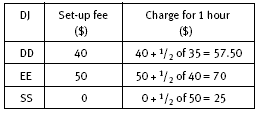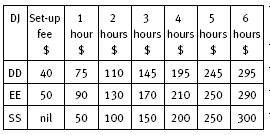This is a level 4 algebra strand activity from the Figure It Out series.
A PDF of the student activity is included.
Click on the image to enlarge it. Click again to close. Download PDF (299 KB)
use a table to find a number relationship
FIO, Level 4, Algebra, Book Two, Which DJ?, page 1
In this activity, students use hire-charge quotes for three DJs to complete a table that lists data for hire charges up to 6 hours. They use the data to decide which DJ has the cheapest hire charge for different time periods.
In question 3, the students investigate the effect of having a DJ hire budget of $130, with each DJ agreeing to halve the charge for their final hour. One approach to this question is to consider the boxes in the table in which the cost is less than $130 (including the set-up fee) and then to calculate whether an additional hour, at half the normal rate, would still cost $130 or less. For example, Dynamic Dave charges $110 for 2 hours. He would normally charge $35 for the third hour but under the agreement would charge $17.50. This means that his total fee for 3 hours would be $110 + $17.50 = $127.50 (which is under $130 as required). Electric Eric charges $130 for 2 hours, so it is obvious that they won’t get 3 hours out of him for $130 or less. Halving the cost of his second hour is $90 + $20 = $110. For Swinging Sally, the calculation is $100 + $25 = $125 for 3 hours. For students who have difficulty setting out the results of their analysis in a useful way, the following sequence of tables may be helpful.
If the final hour is the first hour:
If the final hour is the second hour:
If the final hour is the third hour:
Two of the DJs keep within the budget for 3 hours. All would exceed the budget for 4 hours or more. Swinging Sally is the cheaper of the DJs whose charges don’t exceed $130. So Swinging Sally offers the best value in terms of the budget.
Answers to Activity
1.
2. a. Swinging Sally
b. 3 to 5 hrs. For these hours, he is $5 cheaper than Swinging Sally.
c. 6 hrs
3. a. Dynamic Dave: 3 hrs for $127.50
Electric Eric: 2 hrs for $110. (He would charge $150 for 3 hrs.)
Swinging Sally: 3 hrs for $125
b. Swinging Sally. (She will charge the least, $125, for the longest time, 3 hrs.)




